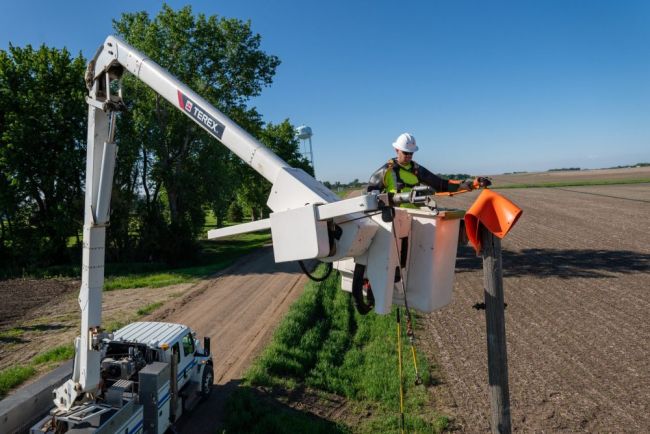
Spec’ing Bucket Trucks to Improve Roadside Safety
Bucket trucks are a big investment, so when the time comes to purchase a new one, it’s important to get it right. Beyond spec’ing bucket trucks based on the application and operating conditions, it’s also important to spec them for safety. Representatives from two bucket truck manufacturers – Altec and Terex Utilities – recently spoke with UFP to weigh in on how to spec bucket trucks for roadside safety.
Fall Protection
Because bucket trucks raise technicians high into the air, fall protection is an obvious safety feature to look for. It is a requirement in the case of a malfunction, overreach or – more commonly – when the load suddenly releases and catapults the operator out of the platform.
To solve for this problem, Terex Utilities developed the Positive Attachment Lanyard (PAL) device.
“PAL alerts by audio warnings to an operator when controls are engaged but the lanyard has not been attached to the lanyard anchor,” explained Justin Pinkalla, regional sales manager for the company. “It can also, if needed, track the results to determine if more training on safe work practices is required.”
Altec’s Lanyard Detection System reminds users to attach their lanyard before working at height. This fall protection system comes in two configurations: the Lanyard Alert and the Lanyard Interlock.
“Units equipped with Lanyard Alert will detect if the lanyard is not attached and sound an audible alarm at the platform when the ISO-Grip interlock is engaged,” said Andy Netzel, senior program manager for Altec Sentry. “The Lanyard Interlock system goes one step further to ensure safer job sites by disabling upper controls operation if the lanyard is not detected, in addition to sounding an audible alarm when the ISO-Grip interlock is engaged.”
Stability Systems
Bucket truck stability systems prevent tip-overs and ensure the unit remains stable during operation. These systems are required and must be used in all conditions; special attention should be paid in adverse weather conditions as well as when working in situations where ground conditions are suspect, which can make a vehicle and its mounted unit vulnerable to instability.
“Bucket truck stability systems play a critical role in enhancing roadside safety,” Netzel said. “Fleet managers should evaluate the environments that their operators work in to better determine the types of outriggers, drivetrains and boom geometry that are appropriate for those conditions.”
Per ANSI A92.2, “Vehicle-Mounted Elevating and Rotating Aerial Devices,” bucket trucks should be operated on firm, flat surfaces and never exceed a 5-degree slope.
“The proper use of outriggers and being aware of the ground slope are important aspects when it comes to stability,” Pinkalla said. “Our units come with a visual slope indicator on the rear and sides of the truck, which is used to help determine that the truck is set up within a safe incline. The proper use – as conditions require – of outriggers, outrigger pads and cribbing also helps with stability. We also offer options such as torsion bars for the smaller trouble trucks without outriggers, so the suspension won’t flex as much, and it helps the trucks’ stability.”
Camera and Speaker Systems
Bucket truck camera systems help truck operators avoid hitting other vehicles, people and objects.
Terex Utilities offers a 360-degree camera system that includes four cameras so crew members can see all the way around the bucket truck from an in-cab display.
“This system is great in detecting anyone or anything that might be close to the truck when it’s parked,” Pinkalla said.
Altec offers a combination of backup and boom cameras, sensors and speaker systems. “These features help to improve safety for ground personnel, improve driver awareness, and ensure operators conducting mobile operation during cable-placing work can be both seen and heard by the driver of the unit,” Netzel said.
Telematics
Telematics devices can collect data from bucket trucks that yields insights about unit performance, how units are being operated and when maintenance is due, all of which can contribute to vehicle health and operator safety.
“Some of the best returns on investment in technology are the ones that ‘communicate’ with the operators and fleet team,” Pinkalla said. “Integrated telematics is one such technology that helps the fleet crew understand how the unit is performing and when the unit is due for preventive maintenance.”
For example, when telematics data shows a unit isn’t performing as expected, fleet managers can take corrective action sooner, preventing problems down the road that could jeopardize safety.
“Altec offers best-in-class telematics to assist fleet managers in monitoring the health of their fleet,” Netzel said. “Our telematics provide insights into operator behavior and help fleet managers identify areas for additional training.”
Start with Operators and Maintenance Teams
Understanding available operator aids is an important part of spec’ing bucket trucks. But both Netzel and Pinkalla said the spec’ing process should begin with those who know bucket trucks best: their operators and maintenance teams.
According to Netzel, “Involving both groups is crucial for ensuring features are both effective and user-friendly. The hands-on experience and practical insights that both groups provide lead to better-informed fleet decisions, which can reduce risk, improve performance and streamline future maintenance.”
“It’s important to bring the right parties to the table when it comes to identifying what is needed when ordering a bucket truck,” Pinkalla added. “The most important piece of advice I would give fleet managers is to spend a day or two with the operators and watch what they do. One area that is easy to forget is ergonomics, so watch how they set up and operate at a work site. Also, ask questions and listen to what they have to say on what would make their jobs easier.”
About the Author: Shelley Mika is the owner of Mika Ink, an Omaha, Nebraska-based branding and marketing communications agency. She has been writing about the fleet industry since 2006.

